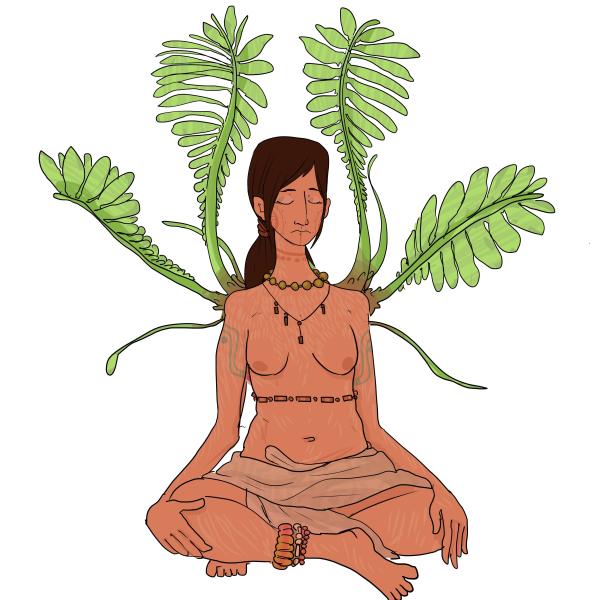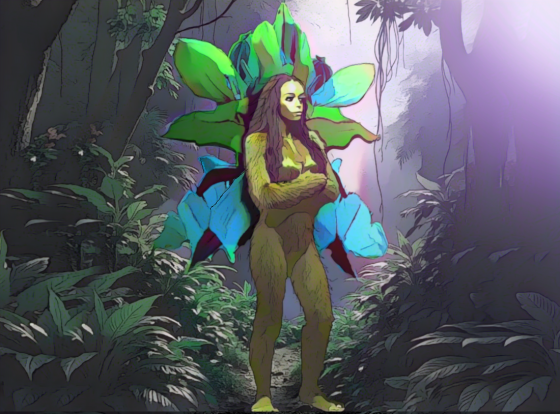BY LETTER
Astomi
 Image from Tharsis13 | |
| Astomi have symbiotic plant-like structures growing from their backs, allowing them to photosynthesise, and tendril-like hair that gathers nutrients from the air. They are aerophytes, extracting resources from the atmosphere and sunlight. | |
History
The design for the Astomi is attributed to the transapient Dimimimon4. Legend has it that the great gengineer based this clade on a mythical race of beings who fed by smelling flowers. Dimimimon4 created the design some time after retiring from public life just to see if the engineering challenges of creating a similar species were surmountable, but e never even considered implementing it. A latter day student of Dimimimon4's methods found the abandoned design in 6,149 a.t. and used it to create the first Astomi in 6,218 a.t.Appearance and Capabilities
Astomi are of unremarkable - but attractive, by human standards - appearance. They have the normal humanoid body plan, with a narrow height and mass range (1.55-1.7 meters, 40-65 kg.). Females tend to be shorter than males, with rounder figures. All Astomi have brown eyes, black hair and light-brown to medium-brown skin, largely covered in fine hairlike tendrils. Males may sport facial hair according to current fashion, and both sexes have luxurious eyelashes. Much of their language and culture is drawn from the Old Earth nation of India.What makes the Astomi unique is their method of feeding; they are filter feeders who take in nourishment from the air. Their body hair consists of invisibly fine tendrils that can retract under the skin. Each hair follicle rests within a special chamber that is filled with digestive enzymes. Airborne particles - usually pollen, microbes and dust - adhere to the tendrils on contact. Chemoreceptors on the skin evaluate trapped particles for food value; acceptable morsels are pulled under the skin and deposited into the digestive pockets while others are ejected back into the air. The species is blessed with a highly efficient metabolism; their food conversion rate approaches 80% (equal to that of cephalopods, which have the most efficient digestion of any known unmodified terragen bionts).
Even the above adaptations would not normally be enough to sustain a life form of humanoid mass because of the limitations of filter feeding. The resource-carrying capacity of air is greatly inferior to that of water (the medium in which most filter feeders live), and humanoid bodies don't have enough surface area to process sufficient air to gather nutrients from. The Astomi overcome this by having symbiotic plants rooted in their body cavities. With the symbiotes retracted the only sign of their presence is a pair of widely spaced slits on the back. When fully extended each symbiote takes the shape of three convoluted fans with radii roughly equal to one-third of the individual's height - an Astomi with extended flora appears to have a huge three-tiered flower growing out of er back. This adaptation more than triples the surface area available for gathering food. Astomi supplement their food intake with photosynthesis; a portion of the glucose produced by the symbiotes is diverted to the humanoid body. The symbiotes appear in a stunning variety of colors and patterns and are often quite beautiful.
Astomi children are born without symbiotes; they are totally dependent on breast milk and skin-filtering until their own flora develop (usually by the age of two). Females deal with this metabolic demand by developing fat reserves in the hips, thighs and buttocks when they achieve reproductive age. Even with this aid the energy demands of motherhood are severe; Astomi women are mostly sedentary throughout pregnancy and for some time after. All Astomi carry dormant spores of the symbiote plants on their skin. Frequent skin-to-skin contact between parents and children passes the plants on to subsequent generations. The plants themselves require humanoid bodies to grow in. Astomi secrete hormones that trigger germination and the plants in turn give off chemicals that suppress the growth of younger plants on the host's skin.
Astomi have an incredibly acute sense of smell due to the chemoreceptors scattered over most of their skin surface. All of them can smell the basic emotional states of other humanoids, and many have learned to use this talent on other bionts. Having chemoreceptors on the skin allows them to detect poisons without ingesting them (an ability shared by some insects, including flies and roaches). Astomi also take in much of the moisture that they need through their symbiotes, thereby reducing the amount of water that they must take in orally. They are comfortable in gravity ranging from microgravity to 0.2 g and air pressures from 1-1.5 atmospheres. This combination of low gravity and moderate pressure is conducive to air that carries high loads of nutrients.. Astomi are perfectly comfortable in conditions where other bionts would require filter masks. The ability to digest pollen and microflora gives Astomi complete immunity to plant-based allergies. Their long eyelashes combine with transparent third eyelids to keep dust out of the eyes, and life in low-gravity orwoods makes them able climbers with little fear of heights.
Astomi require atmospheres that are unusually thick with edible particles. They are ill adapted to environments where the air provides insufficient nutrients; typical space habitats (with their sterilized air) and planets whose atmospheres contain a lot of mineral dust are especially difficult. Astomi greatly prefer tropical pollen-rich orbital environments such as the orwoods for which they were engineered. They can take in food orally but have a strong dislike for doing so. Even in their preferred biome Astomi wear as little clothing as local custom allows (in their own communities they always go nude), and any clothing that they do wear will be air-permeable and cut to allow for symbiote extension. This practice maximizes the surface area available for feeding. Astomi dependence on warm, humid climates and their need to have skin exposed reduces their tolerance for cold. Because of their reduced dentition - Astomi have only 28 teeth - and modified digestive systems Astomi can eat solid food only briefly and in small amounts. Liquid nutrient supplements can sustain them for longer periods. They can survive for at most a few weeks outside of their native habitat. Implants can correct this problem, but Astomi have a strong cultural bias against mechanical enhancement. Biotechnology that allows normal eating is the most common modification sought by Astomi who travel a great deal. Even with such enhancement an Astomi tires easily in gravity higher than 0.5 g; their metabolisms can't handle the extra energy demand. Without medical intervention the Astomi life span is about 300 standard years - somewhat shorter than the norm for humanoids in the Civilized Galaxy.
 Image from Steve Bowers and Night Cafe AI |
Culture
There are less than 20 million Astomi in the Civilized Galaxy, and nearly 70% of them live in the Parvati orwood in which the race was engendered. Outside their home habitat they form culturally distinct enclaves within other communities. Most Astomi are pacifists; their dominant religion is a form of Tantrism. Their culture stresses tolerance of others' ways without allowing oneself to be exploited, and the essential oneness of all life.Astomi are an affectionate people who touch each other often. They gladly extend this treatment to other sophonts if it is welcome. The culture strictly prescribes what sort of touch is permitted based on the nature of the relationship. Casual acquaintances are limited to brief pats or grips on the hands, arms or back. Friends will almost always greet each other with an embrace. Close friends and family members may touch each other's faces and legs and will often sit with their legs touching or intertwined. Astomi don't kiss anyone but family members and those with whom they are so close that they are regarded as "adopted" family. Kissing on the mouth is reserved for lovers and best friends, while a kiss on the forehead is acceptable only if the recipient is significantly younger or of lower station than the kisser. Most kisses are on the cheek.
Astomi don't wear clothing when they can help it, but they do adorn themselves with jewelry. Rings (on the fingers or toes), earrings and nose rings are the most common, but bracelets and anklets are not unknown. Hairstyles and headgear are also common fashion statements. Anything that an Astomi wears will complement the colors and patterns of er symbiotic flora. Personal grooming is highly important; Astomi take great pride in keeping themselves clean and polished. Appearing in public with unkempt symbiotes is particularly shameful.
Sexuality is a prominent aspect of Astomi culture. As Tantrists they regard sex as a spiritual as well as a physical and emotional experience. Ritual sex is the preferred method of striving for a higher state of consciousness, and even purely recreational sex is regarded as a means of ridding the spirit of negative energy. Adolescents are not forbidden sexual contact, but all individuals are surgically sterilized upon reaching puberty. Fertility restoration is only available for those who are married and who pass a state-administered test of emotional stability. Astomi have an "anything goes" attitude toward sex. Homosexuality is uncommon, but about 40% of the population is bisexual. Their only real taboos are against coercion and involving children. In Astomi communities rape and child molestation are equated with murder, and all three crimes carry a mandatory death sentence.
Astomi communities are often organized as eco-resorts where other sophonts come to relax and enjoy natural settings. Most Astomi work in the medical field, or are employed as entertainers or environmental support personnel. The empathy and "people skills" which Astomi culture encourages its members to develop - and in which most of them excel - have led a few individuals to go into politics. No Astomi are known to have ascended to higher toposophic levels.
Related Articles
- Dimimimon4
- Dimimimon4ians - Text by M. Alan Kazlev
Generic term for biont clades created by Dimimimon4 in the mid 5th millennium a.t.. These included Clade Gikk, Clade Cromag, and Clad Fedhead.
Appears in Topics
Development Notes
Text by Michael Walton
Initially published on 11 December 2004.
image by Tharsis13 added May 28, 2025
Image by Steve Bowers added Novermber 1, 2024
Initially published on 11 December 2004.
image by Tharsis13 added May 28, 2025
Image by Steve Bowers added Novermber 1, 2024






